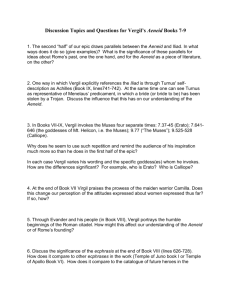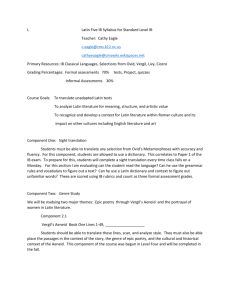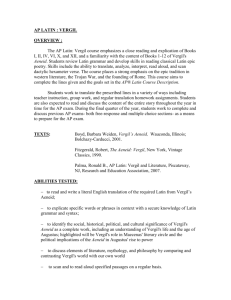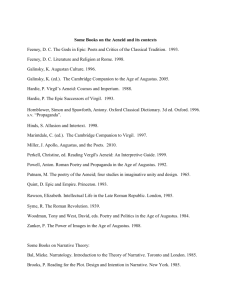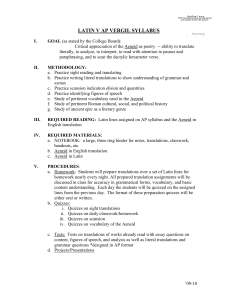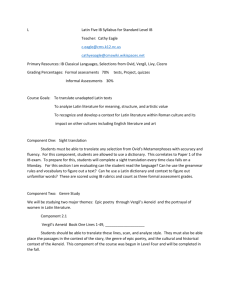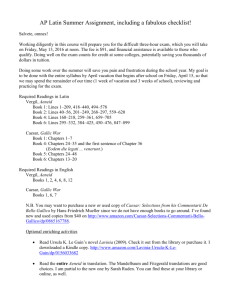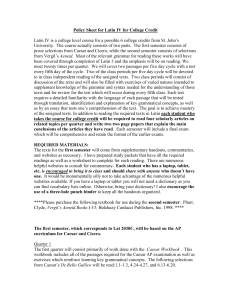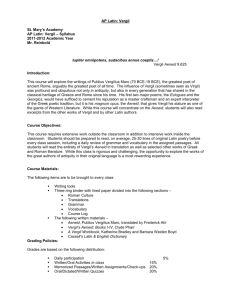AP-Vergil-Summer-Assignment-2011
advertisement
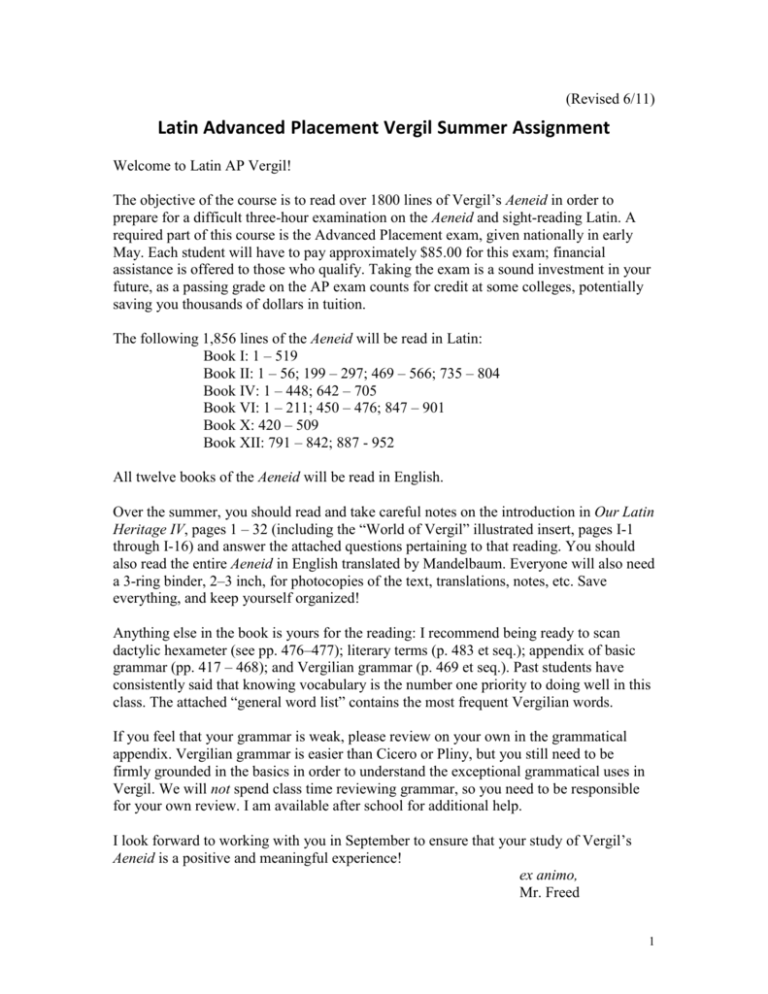
(Revised 6/11) Latin Advanced Placement Vergil Summer Assignment Welcome to Latin AP Vergil! The objective of the course is to read over 1800 lines of Vergil’s Aeneid in order to prepare for a difficult three-hour examination on the Aeneid and sight-reading Latin. A required part of this course is the Advanced Placement exam, given nationally in early May. Each student will have to pay approximately $85.00 for this exam; financial assistance is offered to those who qualify. Taking the exam is a sound investment in your future, as a passing grade on the AP exam counts for credit at some colleges, potentially saving you thousands of dollars in tuition. The following 1,856 lines of the Aeneid will be read in Latin: Book I: 1 – 519 Book II: 1 – 56; 199 – 297; 469 – 566; 735 – 804 Book IV: 1 – 448; 642 – 705 Book VI: 1 – 211; 450 – 476; 847 – 901 Book X: 420 – 509 Book XII: 791 – 842; 887 - 952 All twelve books of the Aeneid will be read in English. Over the summer, you should read and take careful notes on the introduction in Our Latin Heritage IV, pages 1 – 32 (including the “World of Vergil” illustrated insert, pages I-1 through I-16) and answer the attached questions pertaining to that reading. You should also read the entire Aeneid in English translated by Mandelbaum. Everyone will also need a 3-ring binder, 2–3 inch, for photocopies of the text, translations, notes, etc. Save everything, and keep yourself organized! Anything else in the book is yours for the reading: I recommend being ready to scan dactylic hexameter (see pp. 476–477); literary terms (p. 483 et seq.); appendix of basic grammar (pp. 417 – 468); and Vergilian grammar (p. 469 et seq.). Past students have consistently said that knowing vocabulary is the number one priority to doing well in this class. The attached “general word list” contains the most frequent Vergilian words. If you feel that your grammar is weak, please review on your own in the grammatical appendix. Vergilian grammar is easier than Cicero or Pliny, but you still need to be firmly grounded in the basics in order to understand the exceptional grammatical uses in Vergil. We will not spend class time reviewing grammar, so you need to be responsible for your own review. I am available after school for additional help. I look forward to working with you in September to ensure that your study of Vergil’s Aeneid is a positive and meaningful experience! ex animo, Mr. Freed 1 Latin AP Vergil Summer Checklist Read the entire Aeneid in English (Mandelbaum translation) Read and take notes OLH4, pp. 1-32. Answer questions in this packet Review grammar Study vocabulary (“general word list” & quizlet.com) (suggested) Iliad, Odyssey, Lavinia (suggested) Buy, borrow, or share Ronald B. Palma’s AP Latin Vergil Exam (published by REA Test Preps) Any questions? E-mail me, mrfreed@gmail.com 2 Advanced Placement Vergil Questions on the OLH4 Introduction PART I: VERGIL’S WORLD I. Pages 1 – 3 1. 2. 3. 4. What situation did the assassination of Caesar bring about? What did Antony immediately do? Describe how Antony tried to obtain military power. Who upset his plans? How old was Octavius when Caesar was murdered? What was his relationship to Caesar? 5. Describe Octavian’s actions at the time of Caesar’s murder. Who backed him? 6. Describe Antony’s defeat. 7. Who made up the Second Triumvirate? 8. Where and by whom was the last battle to maintain the Republic fought? 9. What happened to Cicero? 10. What happened around 40 B.C. and how was it resolved? 11. What happened in 38 B.C.? 12. Describe Lepidus’ fate. 13. What title did Lepidus hold until his death? 14. Who were Agrippa and Maecenas? 15. How did Antony divide up the east and how did Octavian use this against him? 16. What action did Octavian take in 32 B.C.? 17. Where did the final naval battle take place and who was victorius? 18. Describe the deaths of Antony and Cleopatra. 19. What title did Octavian assume in 27 B.C.? II. The Princeps: his Power and Glory (pages 3 – 6) Describe Octavian’s victory celebration of 29 B.C. Describe the entertainment for the populace. The doors of which temple were closed, and what did this act signify? How did Octavian reorganize the government? Why did he do it in this way? Describe the purge of 28 B.C. What new regulation did Octavian impose on the Senators? What does the term Princeps really mean? Describe Octavian’s actions before retiring and the Senate’s reaction to his retirement. 9. What other powers did Augustus obtain although he had resigned his consulship? 10. Describe what powers Augustus was awarded in 18 B.C., 12 B.C. and in 2 B.C. 11. Describe Augustus’ organization of the civil service. 12. How did Augustus organize the army? 13. What was the state of the treasure under Augustus? 1. 2. 3. 4. 5. 6. 7. 8. 3 III. Religious and Social Reform (pages 7 – 8) Describe the effect of Alexander the Great’s conquests on the cultures he subjugated. What does the term Hellenistic culture mean? Describe Cleopatra’s plans. Define the terms mores majorum and Romanitas. What observances did Augustus reinstitute in his use of religion for political reasons? Define the following Roman virtues: pietas, officium, gravitas, constantia, severitas, disciplina, industria, virtus, and clementia. 7. Describe Augustus’ reforms after 12 B.C. 8. Define Divi Filius. 9. Do you think that the types of reforms Augustus instituted would have worked or not? The answer is strictly your opinion. THINK ABOUT IT! 1. 2. 3. 4. 5. 6. IV. Literature and Art (pages 8 – 12) 1) What type of education did Augustus receive? 2) How was Maecenas involved in the arts? Who was in the group of artists he gathered around himself? 3) Who was Asinius Pollio and what artists did he gather around himself? 4) Who was Messala and what writers did he gather around himself? 5) What patron did Ovid have? What is his most famous work and what is it about? 6) What are some of his other works? What finally happened to Ovid, and why? 7) Who was Livy and what did he write? Describe his work. 8) What unique place did literature achieve during the Augustan age? 9) For what did Augustus use art and architecture? 10) Describe the painters of this time. 11) For what quality were Roman busts and bas reliefs famous? V. Augustus: His Place in History (pages 12 – 13) In a well-written paragraph, describe both the positive and the negative aspects of Augustus’ rule. 4 PART II: PUBLIUS VERGILIUS MARO I. The Life of Vergil (pages 14 – 15) 1. 2. 3. 4. 5. 6. 7. 8. How, when , and where was he born? What was his family background? Describe Vergil’s early education. Describe Vergil’s education and professional activities between 48 and 42 B.C. What happened to Vergil’s family after the battle of Philippi? Who helped Vergil and what was the result? Where did Vergil spend most of his time writing? How, when , and where did Vergil die? What had Vergil instructed Various and Tucca to do with his manuscript of the Aeneid? 9. What actually happened to the manuscript? II. The Works of Vergil (pages 16 – 18) List the three major works of Vergil, the subject matter and the dates of publication. III. Introduction to the Aeneid (pages 18 – 32) Read these pages carefully, and take notes. At this point you will not answer detailed questions, but you are responsible for the main facts about the Trojan War and the story of the Aeneid. PART III: HOMER & LAVINIA As an epic poem, the Aeneid is largely based on the two Homeric epic, the Iliad and the Odyssey. You are strongly encouraged to read either or both of those epics over the summer. The more you read, the better you will be prepared to succeed. Choose a recent translation that you like; Fagles and Lombardo are two of my preferences. At the least, you should familiarize yourself with the basic plot and major characters (e.g. Achilles, Odysseus, Hector, Priam, Diomedes) as told in the original. You should also pay close attention throughout the year to how Vergil reworks the mythology of Homer, adapting to suit a different purpose. Ursula K. Le Guin’s 2008 novel Lavinia is a fun and easy summer read, which gives a voice to Lavinia, the daughter of King Latinus and Queen Amata, who rule Latinum in the era before the founding of Rome. I strongly recommend it. It will give you a better feel for the second half of the Aeneid. 5 PART IV: THEMES IN THE AENEID Throughout the course of this year, you will be writing a number of essays that explore the themes and leitmotifs of the Aeneid. As you are reading the Aeneid in English translation this summer, keep in mind this list of themes, and start to think about which one of these (or another theme) you will research in more depth during the school year. 1. The twin themes of order and chaos overarch the entire epic. Give examples of how characters, events and symbols develop this theme. Furor vs. Pietas. 2. Prophecy appears throughout the Aeneid. Give examples of how direct messages from the gods drive the epic. 3. Omens, symbols and indirect messages play a role in steering the story line of the epic. Cite specific examples of this phenomenon. 4. Women are sometimes critical figures in the epic. Name specific instances where the appearance of a human woman or a group of human women adds a distinctive layer of understanding of the epic and interpret. 5. Reverence or disregard of elders is a theme in the poem. Cite specific examples of either of these and interpret. 6. Sometimes events in the Aeneid seem fair, sometimes not. Refer to particular events in which fairness plays a role and come to a conclusion on the theme of fairness. 7. Aeneas is but one of many leaders in the Aeneid. Choose individual examples of positive or negative leadership and what constitutes each. 8. The gods are always in the background, and sometimes in the foreground, in Vergil’s work. Comment on occurrences of divine intervention, either positive or otherwise, that help the audience understand their role in the epic. Consider the motifs of responsibility, interpretation and pathos. 9. Father and son pairs appear in the Aeneid. Present information that informs the positive and negative characteristics of good and bad father and son interactions. 10. The Aeneid is not just an epic about the immediate followers of Aeneas, but it is also about the Romans, the extended family of the hero. Cite specific examples of events and situations in the Aeneid where Vergil explains an aetiology or in another way show continuity between Trojan, Aenean past and Roman-Augustan present. 11. Devotion to the gods, or lack thereof, serves to characterize players on the epic stage. Refer to certain people and events that illustrate this dynamic. 12. Friendships and alliances emerge as a theme in the Aeneid. Shed light on how this social arrangement works in the poem. 13. Vergil sometimes invites his audience to feel sympathy for individuals and groups technically classified as threats or enemies. Develop how the poet does this by naming specific cases of this and offer an interpretation as to how this is consistent with the greater themes of the epic. 14. How one treats the dead is of import in the Aeneid. Discuss instances where reverent and irreverent treatment of the deceased functions in the work and conjecture as to why Vergil has included this topic in his poem. 15. There are many exemplary youths in the Aeneid. Name some of the positive and negative attributes of young men, giving examples. Comment on why many of these youths die so tragically. 6
